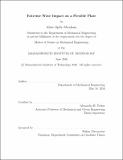Extreme wave impact on a flexible plate
Author(s)
Abraham, Aliza Opila
DownloadFull printable version (16.80Mb)
Other Contributors
Massachusetts Institute of Technology. Department of Mechanical Engineering.
Advisor
Alexandra H. Techet.
Terms of use
Metadata
Show full item recordAbstract
This thesis describes the use of a combination of various visual techniques to characterize the flow-structure interaction of a breaking wave impacting a flexible vertically mounted plate. Several experiments were conducted on a simulated dam break in which water was rapidly released from a reservoir to generate a wave, which impinged on a cantilevered stainless steel plate downstream. Two high speed cameras collected data on the water and the plate simultaneously. Manual tracking of the wave front and Particle Image Velocimetry (PIV) were used to gather water height, wave speed, crest speed, vorticity, and particle speed, which were used to determine the pressure exerted by the water on the plate. An algorithm was written to track the edge of the plate to find plate deflection over time. The dynamic beam bending equation was used to find the forces experienced by the plate, which were compared to the pressure results. A series of waves of different heights and breaking locations were tested, controlled by the ratio of the height of water initially in the tank and the height of water in the dam break reservoir, for two different plate locations. The properties of the wave varied depending on these parameters, as did the deflection of the plate. The plate deformed more and the recorded velocities in the wave were higher when the depth ratio decreased and when the plate was moved farther from the reservoir. These results shed light on the effect of breaking wave impacts on offshore structures and ship hulls, taking into account the elasticity of these structures. They also provide a test case for future numerical fluid-structure interaction simulation techniques.
Description
Thesis: S.M., Massachusetts Institute of Technology, Department of Mechanical Engineering, 2016. This electronic version was submitted by the student author. The certified thesis is available in the Institute Archives and Special Collections. Cataloged from student-submitted PDF version of thesis. Includes bibliographical references (pages 99-102).
Date issued
2016Department
Massachusetts Institute of Technology. Department of Mechanical EngineeringPublisher
Massachusetts Institute of Technology
Keywords
Mechanical Engineering.